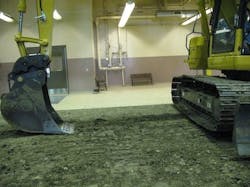Quick Coupler Cautions
Quick couplers, those handy hydraulic devices that conveniently connect buckets to an excavator arm, are becoming standard equipment on many manufacturers’ excavators and are a popular aftermarket add-on. The couplers come in several designs and all offer the same conveniences: simple connections that many times allow the operator to stay in the cab, faster switch out times, and the ability to accommodate various manufacturers’ attachments.
But construction safety experts have noticed that as the number of contractors using quick couplers increases, so has the number of accidents involving the devices. Unintended bucket releases are the most common incidents. Todd Petersen at the Apprentice and Skill Improvement Program (ASIP) says, “We are seeing situations where a worker is in the trench box and the bucket falls off the coupler. It happens so quickly he can’t get out of the way of the falling bucket fast enough. The bucket traps and sometimes kills him.”
In his hydraulic coupler training video, Larry Kapper, safety director for Paladin Light Construction, says he studied more than 200 accidents that involved buckets separating from quick couplers and found that 98 percent of the incidents involved lack of operator training or operator error. “The operator is the last line of defense for safe operations,” says Kapper.
Dominick Ventura, an instructor at ASIP, also notes that some coupler configurations make it difficult to impossible for the operator to see if the connection is locked from his viewpoint in the cab. There are few visible indicators of a locked connection. Ventura says the only way an operator can safely determine if the coupler is secure is to do a "bucket test” every time he changes buckets or powers on the machine.
Bucket test for secure coupler attachment
Place the dipper stick and bucket vertically and to the side of the cab. Ventura says side testing allows for better visibility.
Rest the bottom of the bucket on the ground, tooth side facing the cab.
Apply pressure down on to the bucket until the bucket’s belly lifts off the ground and the bucket is resting on its teeth.
Continue to press down until the excavator’s tracks lift about 6 inches off the ground. Push RPM up a bit for good measure.
If the bucket takes the pressure and holds, the coupler is locked in place.
Even though some couplers have redundant locking features, the best practice is to do the bucket test every time.
Not all blame for coupler accidents rests on the operator’s shoulders. Although the coupler itself may be functioning correctly, faulty installation can cause an accident. “Sometimes a contractor will attempt to install the coupler himself or hire an unqualified installer,” Petersen says. “If an aftermarket coupler system is incorrectly installed, perhaps in an attempt to save a few dollars, the audio and visual alert system can fail and the operator won’t know there is something wrong with the coupler.”
If the excavator arm swings too fast and the coupler connection isn’t locked, the bucket can disconnect and sail into nearby workers, equipment and structures.
Peterson says lifting and moving materials such as pipes requires that the lifting chains are attached to the coupler’s lift eye, never on the eye that may be on the back of the bucket. Take the bucket off the coupler before attaching the chains. This will take excess weight off the excavator and provide much better visibility for the operator.
Inspect the coupler to see if there is a manual safety procedure such as a pin-lock mechanism that requires a second person to insert the pin to complete the connection.
Use an independent secondary safety system to keep the bucket attached in the event the primary system fails. This may be a lock-out/tag-out verification procedure that is part of the equipment’s daily system check.
Keep the coupler free of mud, debris and ice. The stopping mechanism on some couplers only measures about an inch, and excess material may interfere with proper attaching procedures.
Keep the bucket close to the ground during all locking and unlocking operations.
Don’t reverse the orientation of the bucket so that it is facing away from the excavator, as in a shovel position. The locking mechanism won’t work. (If in doubt, check with your dealer.)
Keep your hands out of the coupler. High-pressure hydraulic fluid lines can be fatal if they force leaking hydraulic fluid into your skin.
Don’t modify the connections on either the bucket or the coupler, such as adding a reinforcement plate. Modifications interfere with the locking mechanisms.
